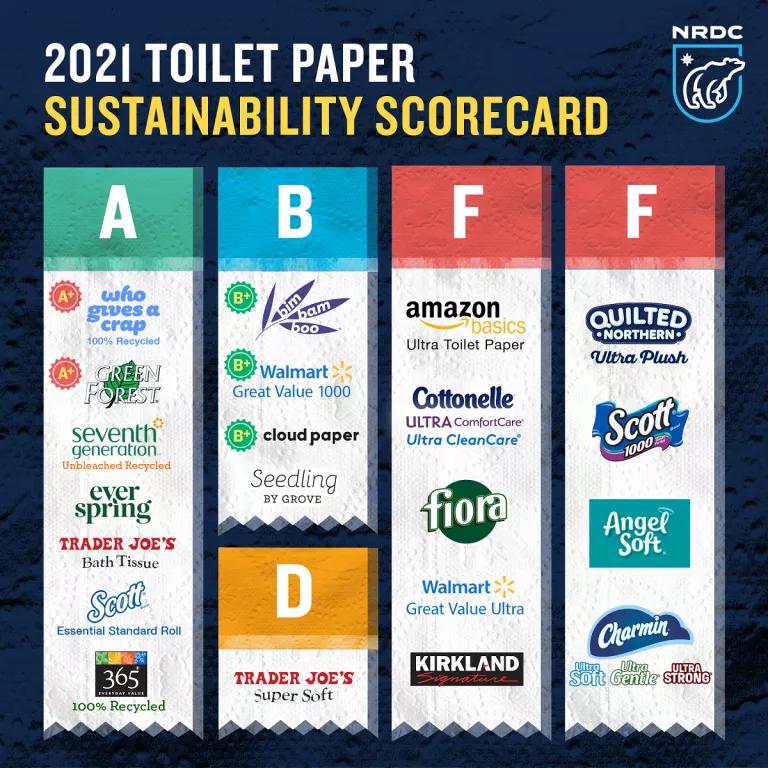P&G Stuck in the Past in a Shifting Tissue Marketplace
The 2021 Issue With Tissue scorecard shows many companies have made major shifts toward sustainability, but laggards like Procter & Gamble (P&G) remain stuck in the past.

Few products endured as much upheaval in the pandemic era as toilet paper. The Great Toilet Paper Shortage of 2020 created supply chain crunches and empty tissue aisles nationwide for weeks. While this disruption was difficult for many families, it created an opportunity for many toilet paper start-ups to gain a foothold in the market and for many consumers to find new, more sustainable brands.
This development is important because the toilet paper industry has been in dire need of disruption for many years. As NRDC’s 2019 and 2020 Issue With Tissue scorecards have shown, the largest tissue brands in America are failing the climate, communities, and biodiversity by creating throwaway products from trees, particularly from Canada’s boreal.
The boreal is the largest remaining primary forest on the planet, is home to hundreds of Indigenous communities, and stores the carbon equivalent of twice the world’s oil reserves. But brands like Charmin, Cottonelle, and Quilted Northern are flushing the boreal forest down the toilet.
As the climate crisis worsens, the industry’s continued reliance on a devastating “tree to toilet pipeline” has become only more untenable. With heat waves, flooding, and rampant wildfires across the United States, and with the IPCC sounding the alarm that addressing the climate crisis is more urgent than ever, people are searching for ways to mitigate their own impact while also pushing major corporations to accept their own, much larger, role in fueling climate catastrophe.
NRDC’s new Issue With Tissue 3.0 scorecard contains more products, across toilet paper, facial tissue, and paper towels, than any previous iteration. The growing list shows just how much the market has changed in the last year and a half, broadly shifting toward more sustainable products that offer greater consumer choice. This year’s scorecard includes 95 brands, 36 of which have not been scored before. Of the 95 products, 45 received a B grade or higher, with products made from post-consumer recycled content receiving the highest grades because of those products’ lower carbon footprint and reduced forest impact. (Tissue products made from recycled content have one-third the carbon footprint of virgin fiber tissue products, according to the Environmental Paper Network’s Paper Calculator 4.0.)
One of the most promising developments this year is that Kimberly-Clark, one of the three largest tissue manufacturers in the United States (which are P&G, Kimberly-Clark, and Georgia-Pacific), is now offering its Scott Essential Standard Roll, made from 100% recycled content and at least 50% post-consumer recycled content, online directly to consumers. This makes Kimberly-Clark the first of the “Big Three” to earn an A grade for any of its products, putting it far ahead of P&G and Georgia-Pacific.
While Kimberly-Clark deserves kudos for making this more sustainable product available for consumers, the company purchased more than 600,000 metric tons of natural forest fiber in the last year for its products, a volume increase of 16.7% over the previous year. Kimberly-Clark also still makes Cottonelle and Kleenex from 100% forest fiber. The next step for the company to demonstrate its leadership should be to stop sourcing from climate-critical primary forests entirely.
This year’s scorecard also includes a new category, bamboo tissue products. Bamboo products have been growing in popularity for the last few years. Bamboo is an alternative fiber to traditional forest fiber for making tissue. It grows rapidly, and typically has a lower ecological footprint than forest fiber. That said, some bamboo plantations were created by deforesting primary forests, and therefore bamboo sourced from these regions should be avoided.
To ensure bamboo is sustainably sourced, it’s important for bamboo products to carry the Forest Stewardship Council (FSC) logo. FSC helps to guarantee that bamboo tissue products avoid deforestation of primary forests and that they meet a number of other sustainability metrics. The 2021 scorecard assigns more points to bamboo products that bear the FSC logo on their products.
But while so many companies are finding ways to offer more sustainably made products to consumers, the one company that has arguably faced the most pressure to change in the last few years remains stubbornly stuck in the past.
For the third year in a row, all of P&G’s tissue products received F grades. P&G continues to make Charmin, Bounty, and Puffs almost exclusively from virgin forest fiber. Despite the clear risks associated with sourcing from Canada’s boreal forest, P&G actually increased the volume of forest fiber it buys from Canada by 15% this past year. And while the company increased its footprint in Canada, it continues to greenwash products like Charmin publicly, using its billion dollar advertising budget to hide its impact on forests and communities.
This lack of progress and even backsliding in the boreal is stunning because P&G faced a resounding rebuke of its current operations at their 2020 annual shareholder meeting, where 67% of voting shareholders supported a resolution calling for the company to determine how it could eliminate deforestation and intact forest degradation from its supply chains. This was the first ever forest-related shareholder resolution to pass in any corporation’s history.
Instead of taking action, P&G’s leadership has failed its shareholders and consumers by continuing to flush the boreal. As so many companies sail ahead to offer sustainably-made tissue products, P&G leadership is miring the company in outdated, globally harmful practices.
P&G must heed the calls of consumers, shareholders, and scientists to own its role in fueling forest loss. Saving our planet from climate collapse requires dismantling the tree-to-toilet pipeline that is flushing away some of our most important natural climate allies. Now is the time for real leadership from the biggest players.


